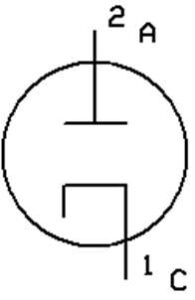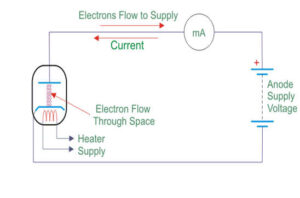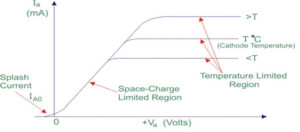- The first vacuum diode is invented by Sir John Ambrose Fleming in 1904 which is also called a vacuum tube.
- A vacuum diode is also known as a Fleming valve and thermionic tube.
- It is an electronic device that allows the electric current in one direction from cathode to anode and blocks the current in another direction from anode to cathode.
- The vacuum diode symbol is shown in the figure.

Working of Vacuum Diode
- voltage to the anode concerning the cathode then it works on the principle of thermionic emission.
- A filament heats this cathode. Hence electrons get emitted from the cathode and attracted towards the anode. If the positive voltage is applied to the anode, the anode cannot attract the electrons emitted from the cathode due to the hot filament.
- Respectively, one cloud of electrons gets accumulated in the space between the cathode and anode. This is called space charge. Due to this space charge, the further emitted electrons get repealed and come back to the cathode. Hence virtually electron emission stops. No current flows through the circuit.
- If the voltage is applied between anode and cathode then more space charge electron comes to the anode and creates vacant space, so with the increase of voltage across the anode and cathode, we can increase the emission rate of the electron.
- At the same time, the space charge vanishes foe a certain voltage is applied between the anode and cathode. The emission of electrons from the cathode gets to stop and a beam of electrons starts flowing freely from the cathode to the anode through space. Appropriately, current flows from the anode to the cathode.

- If the anode is negative such that case voltage applied in the reverse direction cannot cause electron emission in ordinary circumstances. Thus an electron current cannot exist from the anode to the cathode.

Applications of Vacuum Diode
- The vacuum diode is used in radios, microwave ovens, Televisions, early computers, Bluetooth, mobile phones, Wi-Fi transmissions, and even in satellite & radar communication devices.
